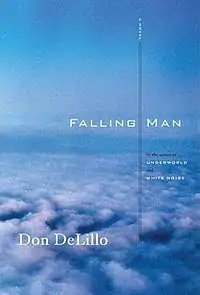Falling Man (novel)
Falling Man is a novel by Don DeLillo, published May 15, 2007. An excerpt from the novel appeared in short story form as "Still Life" in the April 9, 2007, issue of The New Yorker magazine.
 Cover to the first edition | |
| Author | Don DeLillo |
|---|---|
| Country | United States |
| Language | English |
| Genre | Novel |
| Publisher | Scribner |
Publication date | 2007 |
| Media type | Print (hardback) |
| Pages | 256 (hardback first edition) |
| ISBN | 1-4165-4602-2 |
| OCLC | 76901941 |
| LC Class | PS3554.E4425 F36 2007 |
Falling Man concerns a survivor of the 9/11 attacks and the effect his experiences on that day have on his life thereafter.
Plot
During the September 11 attacks, Keith Neudecker, a 39-year-old lawyer who works in the World Trade Center, escapes from the building injured slightly and walks to the apartment he previously shared with his son Justin and estranged wife Lianne. After a period of convalescence recuperating from the physical and mental trauma experienced in the attack, Keith resumes his domestic routine with Lianne while at the same time broaching a romantic relationship with a woman named Florence, another survivor, whose briefcase Keith absent-mindedly took with him from a stairwell upon exiting the tower. Lianne meanwhile grows frustrated with a neighbor in her building who loudly plays Middle Eastern-sounding music, witnesses the dissolution of a writing group she ran for Alzheimer's patients, and spends time with her elderly intellectual mother Nina and her boyfriend Martin (an art dealer who was involved in Kommune 1 in Germany during the 1970s). In the second half of the novel, Keith eventually abdicates his partially resumed domestic life and begins touring the world playing in professional poker tournaments full-time, recalling his weekly poker nights with co-workers, one of whose deaths he witnessed on September 11.
Throughout the book, Lianne sees a performance artist dubbed "Falling Man" in various parts of the city. Wearing business attire, he suspends himself upside-down with rope and a harness in the pose of the man in the famous photograph of the same name by Richard Drew.
Themes
Like DeLillo's previous works, this novel is thematically concerned with the symbolic nature of terrorist violence portrayed through the mass media. In addition, Delillo's narrative examines the possibilities of reinventing individual identity as well as the tendency of individuals to construct their identities through a group mentality.[1] The Falling Man himself is symbolic of "the hubris of trying to make art out of horror."[2]
Reception
Michiko Kakutani writing for The New York Times considered it a disappointment, saying that although "flashes of Mr. DeLillo’s extraordinary gifts for language can be found in his depiction of the surreal events Keith witnessed on 9/11 . . . the remainder of the novel feels tired and brittle."[2] World Socialist Web Site critic Sandy English concluded that parts of the novel were "moving, and one can learn something about the reactions of a particular social layer in New York at the time," but as a whole it "does not succeed as a unified work of art. It falls short of the significance of the events themselves."[3]
Some critics were more positive: both Laura Miller in Salon and Jennifer Reese in Entertainment Weekly described it as DeLillo's best novel since Underworld in 1997, with Miller noting that "DeLillo is a master of the prose riff, and there are a few riffs in here as good as anything he's ever produced."[4][5]
References
- O'Hagan, Andrew (June 28, 2007). "Racing against reality". The New York Review of Books. 54 (11): 4–8.
- Kakutani, Michiko (2007-05-09). "A Man, A Woman, and a Day of Terror". The New York Times. Retrieved 2007-05-15.
- English, Sandy (27 August 2008). "Casting about for the truth of 9/11: Don DeLillo's Falling Man". World Socialist Web Site. Retrieved 2016-07-19.
- Miller, Laura. "Falling Man". Salon. Archived from the original on 2007-05-15. Retrieved 2021-01-05.
- Reese, Jennifer. "Falling Man". Entertainment Weekly. Archived from the original on 2018-12-16. Retrieved 2021-01-05.